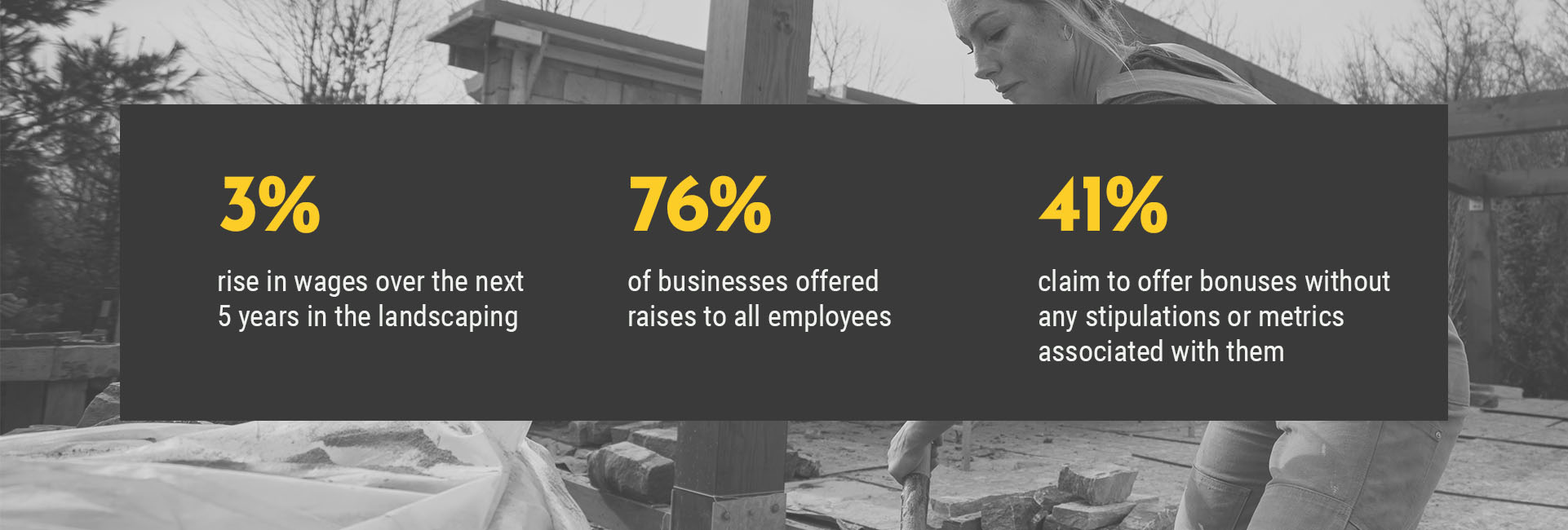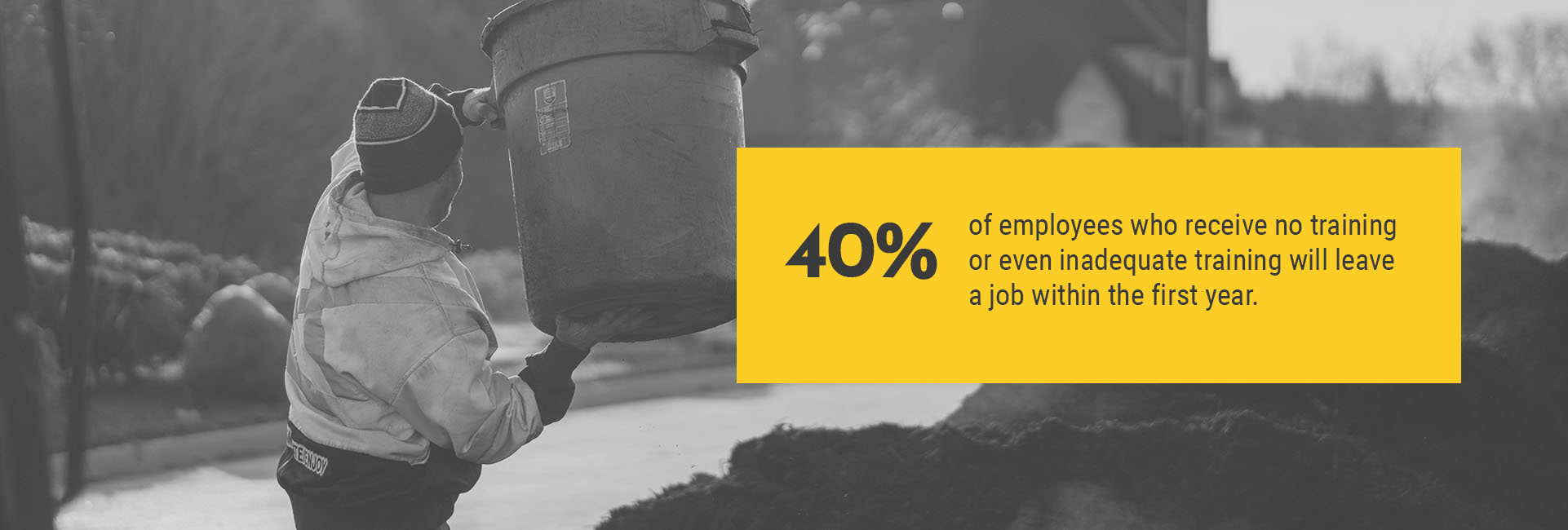The post All About Outsourcing appeared first on Bruce Wilson & Company.
]]>
Three key issues in the commercial sector are driving the demand and urgency for more green. One, sustainability has moved up the corporate priority list. Two, tenants are willing to pay a premium for best-in-class green spaces. And three, property owners, developers and mangers are increasingly reallocating capital to climate-positive strategies because there’s risk in owning assets that don’t meet sustainability goals.
For landscape companies targeting high-value commercial real estate clients, green is a multi-billion-dollar business opportunity, especially when it comes to integrating on-structure landscaping, green roofs and walls, and ‘living architecture’ as a way to give underutilized properties a second chance. Landscape contractors with experience in this sector already see it as an opportunity zone.
There has never been a better time to decide if outsourcing is a strategy that could work for your business. We’ve found that the decision to outsource vs. hire in-house often comes down to how forward-thinking we are when it comes to taking risks. We must also determine how fast we can get needed talent with needed skills at the right price. There are many ways for companies to be efficient, cut costs and gain competitive advantage, and outsourcing may or may not be the answer. But with remote work not going away and every organization already operating with some version of a hybrid model, sourcing external knowledge to fill talent gaps has become an essential ingredient for innovation.
Here’s how to identify if it’s right for you:
In-House vs. Outsourcing Pros and Cons. There are three vital factors to consider: cost, expertise and flexibility. Outsourcing enables businesses to quickly scale and mobilize on a project, access experienced talent in a targeted discipline and get assignments completed and delivered faster.
On the flip side, it’s important to understand the drawbacks it can have on company culture. While outsourcing can give your company strategic expertise, it can lower employee morale if employees feel they are being replaced. Clear communication, team building and opportunities for advancement and training can help your staff feel valued and optimistic.
7 outsourcing trends to watch:
1. Information Technology
Companies can save time and money outsourcing to experts who can help employees understand the digital universe and apply the tools they need to work smarter and faster. As cloud technology and AI expands, vendors may begin consolidating services to make it easier for companies to access ongoing insight, training and support. For example, a CRM expert could be used to build out a new system, provide initial training and monitor for three to six months to troubleshoot.
2. Fractional Executives-Finance
A growing number of companies are hiring fractional CFOs (chief financial officers) and plug-in finance departments or accounting teams to help manage spending, financial strategy and risk management. If you’re a small business or a start-up, you can hire an experienced fractional CFO with deep industry knowledge who doesn’t require a lengthy tenure and is an objective, cost-effective problem solver at a fraction of the cost of a full-time hire.
3. Fractional Executives-Marketing
Fractional CMOs (chief marketing officers) are ideal for medium-sized businesses without the resources to hire a full-time marketing director or marketing services team or agency to help with market research, collateral, content and digital marketing. Like other fractional C-suite positions, interim executives bring perspective, experience and an understanding of the industry and target audience without the overhead of a full-time salaried position.
4. Fractional Executives-Sales
Fractional CROs (chief revenue officers) give companies a boost in sales leadership without the cost and effort that it takes to recruit and onboard a full-time sales leader position in a tight labor market. For business owners looking to accelerate revenue growth, outsourcing to an experienced executive on an interim basis can jump start the process.
5. Business Processes Management
Further down the org chart are non-customer facing operational functions being outsourced to external companies with specialized expertise in front- or back-office functions that can fill critical needs in payroll, cost estimating, validation studies, property mapping, safety training and procurement.
6. HR Management
For businesses with less than 200 employees, outsourcing various HR services such as employee compensation and benefits administration, workforce administration, legal compliance, workers’ comp, talent management, recruiting and onboarding to industry specific experts solves capacity issues, delegates non-core work, and puts the people-focused work of human resources back to the internal human who does it best, without administrative overload.
7. Customer Service
A growing industry of articulate and knowledgeable customer concierge and CRM experts are becoming essential value-adds, offering 24/7 customizable support and handling everything from fielding inbound and outbound calls, leads and emails, analytics and website visitors.
Be sure to join the conversation at https://www.lawnandlandscape.com/article/all-about-outsourcing/
Reprinted with permission. GIE Media. Lawn & Landscape August 2023 (c)
The post All About Outsourcing appeared first on Bruce Wilson & Company.
]]>The post 6 Ways to Grow Green appeared first on Bruce Wilson & Company.
]]>For landscape companies targeting high-value commercial real estate clients, green is a multi-billion-dollar business opportunity, especially when it comes to integrating on-structure landscaping, green roofs and walls, and ‘living architecture’ as a way to give underutilized properties a second chance. Landscape contractors with experience in this sector already see it as an opportunity zone.
If you’re looking to implement green initiatives, the long-term benefits far outweigh the costs.
1. Is the green conversion trend nationwide?
Some states are signing bills into law that incentivize developers to convert commercial buildings into much-needed residential space, including mixed-use options. If your state isn’t among them, or zoning regulations are an obstacle for now, keep an eye on commercial development pipelines, stay close to your developer/owner customers so you can pivot when ready. Not every strategy works for every opportunity but by understanding the requirements and challenges, you’ll be able to move first.
2. Are conversions really the wave of the future?
While commercial repurposing and retrofitting has existed for decades, the growth potential was accelerated by the pandemic and empty office space. Every owner, developer and property manager needs the financial benefits that come with green conversions. Landscape contractors able to capitalize on this trend can not only communicate a commitment to green building practices but benefit from positive returns over the long term.
3. Where can I learn more? If you don’t have the bench strength or the capability now but want to ramp up, network with the Commercial Real Estate Development Association and the Building Owners and Managers Association, and do your homework. CBRE, JLL, Cushman & Wakefield and Urban Land Institute regularly publish insights that can help you plan beyond your traditional positioning and give you time to strengthen your focus.
4. How do I find opportunities?
Talk with your existing commercial clients at trade shows and targeted events. Talk to CEO colleagues in your peer groups who have built expertise in this area and learn what the process is like from the inside.
5. How do I create a successful green strategy?
Keep it simple with one or two critical targets and the steps that can multiple your effectiveness. A plan to capture more green work will come with logistical, operational and messaging challenges, but there are people who can help and ways to test your plan before you take action. Ask yourself: Does your current approach resonate with where your commercial accounts are going? Could having a sustainability framework contribute more to your performance and bidding success? Could expanding your green expertise serve as a platform for further innovation and growth?
6. How do I differentiate in a crowded market of sustainability messaging? Use data to quantify the green premium of landscaping, such as: linking landscaping to value creation, the cost savings you’ve produced for your clients by meeting performance standards for energy efficiency, safety, waste reduction, water and resource conservation, carbon sequestration and environmental quality. Build a portfolio of LEED projects and a resume of expertise in stormwater quality and erosion control, integrated pest management, habitat restoration and water-smart and pollinator-friendly landscaping. Give qualified members of your team LEED Green Associate training and credentialing to boost your company’s credibility as a knowledge partner.
Reprinted with permission. GIE Media. Lawn & Landscape July 2023 (c)
The post 6 Ways to Grow Green appeared first on Bruce Wilson & Company.
]]>The post Win The Future appeared first on Bruce Wilson & Company.
]]>- A clear and relatable mission, vision and values statement that connects the company’s purpose to employee engagement and give all employees something to believe in and work toward.
- A well-defined path for career growth. If you want employees to produce results for your company, they have to have a way to create their own future, not just do a job. This is especially important for younger generations who are free agents, jumping from job to job for 25 cents an hour more to see what they like. If you only give them a job and they do not see a future, be prepared for them to go somewhere else.
- A recruiting strategy. Top companies hire for cultural fit and create value-aligned teams. People generally like being around people with similar values, just like successful people like being around other successful people. When employees and teams have good chemistry, cooperate, share and work well together, productivity not only improves at the project level, but it’s a key driver of profitability and customer satisfaction.
- A plan to recover from bad hiring decisions. When companies hire people that don’t share the same values and the relationship can’t be salvaged, they need to learn what went wrong to avoid repeating the situation, cut their losses quickly and eliminate employees that do not fit rather than allow the problem to fester.
- A walk-the-talk commitment to reinforce positive behavior and lead by example. Behavior affects reputation, relationships and the bottom line. Successful companies that focus on behaviors that complement a forward-thinking culture deliver better financial results.
Four behaviors that are essential to competing in the digital age
- Sense of urgency. The speed at which a company solves problems is extremely important in a hyper-competitive service environment. No longer do big companies have the edge over small companies. Amazon has created a “fast beats slow” expectation for fulfillment and customers no longer want to wait. If they want an answer to a question, they Google it. This is especially true in residential work where the company that responds first, gets the job.
- Sense of purpose. People who have purpose at work are more productive. When companies do a good job making employees feel connected to the bigger picture, it results in higher engagement and better outcomes. Employees must understand and believe in what they are doing and how they are contributing to the greater good and the role they play in driving success. If companies don’t help their employees find purpose in the job they do, they will leave for a company that will. A sense of purpose overcomes problems and prevents burnout. Purpose goes hand-in-hand with a sense of urgency.
- Promote from within. Providing opportunities for employees to grow will help companies attract and retain talent and keep top performers from leaving. When combined with colleague-to-colleague mentoring, a “train your replacement” mindset and upskilling, internal mobility empowers employees to take ownership of their careers. Workforce agility is an essential part of a culture of continuous learning, which is necessary for a company to improve its competitiveness in the marketplace.
- Continuous learning. Peter Senge, author of the Fifth Discipline, wrote that “learning faster than the competition is the only lasting competitive advantage.” If implemented correctly, a continuous learning culture can develop internal future leaders and inspire innovation. When employees at every level are committed to relentless improvement, it’s the most powerful way for employees across every generation to increase the effectiveness of the entire organization and produce a sustainable flow of value.
Reprinted with permission. GIE Media. Lawn & Landscape June 2023 (c)
The post Win The Future appeared first on Bruce Wilson & Company.
]]>The post DISC Assessments & The Benefits of Understanding Your Team appeared first on Bruce Wilson & Company.
]]>Diving into DISC The DISC model is not about making your team fall into a line-up of neatly organized categories. Rather, it provides insights into how individuals interact and communicate based on their unique personality traits. With DISC, you’re equipped to lead yourself, your team, and enhance your customer experience, fostering a healthier and more productive work culture in the process.
DISC is an acronym for Decisive, Interactive, Stabilizing, and Cautious, mapping out various personality traits and behaviors. Mastering this tool equips you to connect faster and more effectively with your team as you gain an understanding of their distinct style of functioning.
Unpacking DISC Personalities
The Decisive (Dominant) Personality Interactive personalities, otherwise known as influencers, are charming and sociable individuals who thrive in people-centric environments. Their focus lies in creating strong relationships within their team, even though they may occasionally falter on tasks and details. Roughly 25% of individuals fall into this category. In a hiring situation, an Interactive personality prioritizes personal connections over specific skills.
The Stabilizing (Steady) Personality Stabilizing personalities are the backbones of your team. They’re reliable, supportive, and excel at active listening, contributing to a serene and steady work environment. They tend to shy away from conflict and may need some encouragement to share their invaluable insights. Approximately 40% of people are of the Stabilizing personality type. When hiring, they value cultural fit and interpersonal compatibility.
The Cautious (Conscientious) Personality Cautious personalities are the meticulous individuals in your team. They are detail-oriented, love processes and structure, and solve problems with remarkable accuracy and logic. They may seem rigid, but their pursuit of perfection contributes to excellent results. About 25% of individuals are Cautious personalities, and their focus is on how tasks are done. In a hiring situation, they meticulously look for the perfect match in terms of attitude, skills, and performance.
Building Bridges with DISC Personalities Consider a hypothetical scenario where each DISC personality type is given the task of building a bridge.
Decisive personalities plunge into action, valuing progress over perfection. Interactive personalities revel in the people-oriented aspects of the task, planning celebrations and engaging in public relations. Stabilizing personalities carefully consider the impact of their actions on the team and commit themselves fully once they are convinced of the value of the task. Cautious personalities meticulously plan out every detail, ensuring accuracy and top-notch quality in their results.
In the end, a combination of all these types is needed to deliver a successful outcome. As a leader, your role is to facilitate communication and foster unity amongst these diverse personality types.
The Utility of DISC in Your Business Cultivating a team spirit and fostering a culture of unity is paramount for a successful business. Creating this ‘we’ mentality builds trust, improves communication, and reduces conflict. The DISC assessment tool is a powerful means to this end, facilitating an understanding of diverse communication styles and behavioral tendencies.
A recent study revealed that a significant percentage of millennials and Gen X dread going to work on Mondays, highlighting the importance of mental well-being in the workplace. They crave validation and value from their employers. Implementing the DISC assessment tool in your business is a great step towards building a culture where every team member feels appreciated and valued. It empowers you to lead and motivate your team more effectively, fostering a more harmonious and productive work environment.
If you have any interest in taking a free test, please contact robert@theradixgroupllc.com
The post DISC Assessments & The Benefits of Understanding Your Team appeared first on Bruce Wilson & Company.
]]>The post 2 Critical Data Analytic Tools You Should Master appeared first on Bruce Wilson & Company.
]]>
When CEOs tell me they’re drowning in data, they’re not wrong. With increasingly more intelligent technology, it’s getting easier to access information and harder to find the wisdom to understand it. But because we need data to make decisions, we dive in, unsure how to discern or extract the nugget that will change our business for the better.
If you are swimming through a sea of data, two foundational approaches to a data strategy can form a life raft, helping you know what to do and where to head next: dashboarding and benchmarking. Dashboarding is like the raft’s base, consolidating the nuts and bolts of your business, providing key financial and production data that drives performance and gives a concise overview of overall health in critical areas. It provides insights that drive key decisions surrounding growth, pricing and profitability.
Benchmarking is a big-picture approach, the raft’s rudder, measuring your historical performance against itself, competition and the industry. It powers your ability to grow in your market by showing you opportunities for improvement, or where you have a competitive edge. When paired together as the foundation of your business strategy, the value is immeasurable.
Financial Dashboard Value
Good financial management occurs by actively controlling what is in front of you, not passively observing what is already behind you. Determining specific data needed and sources to supply it, along with a way to consolidate it, is at the very heart of a successful financial dashboard. Long gone are the days when simply reviewing an income statement and balance sheet after the month closes results in good decision-making. Today’s fast-paced environment of almost instant information demands timely, accurate data with which to make fully informed decisions.
Data-Driven Decision Making
Data volume does not equate to data value or even data validity. Conclusions based on timely, supporting data help take the guesswork out of evaluating performance and making strategic decisions, though only if that data is accurate and reliable. Good data is rooted in timely, scalable and consistent processes. For example, an electronic time system that is correctly used by field crews can accurately track time worked for payroll and time on each job, producing accurate labor cost data, which makes bidding and management decisions surrounding pricing timelier and more accurate. The better and timelier a company’s access to reliable data, the bigger their competitive advantage in the market.
Finding and Correcting Weakness
Customers expect to pay a fair price for the services you provide. Too often, they end up paying for inefficiencies, sometimes ultimately resulting in the loss of a good client. The industry generally benefited from generous price increases over the last few years as wages and other costs of production soared. Today, though, the market is in flux, and those increases won’t be as easy to get. Dashboard analysis provides context for operational and administrative costs and gives the insight needed to improve margins and the bottom line. For example, knowing the benchmark gross margin for companies with a similar service mix to our own allows us to determine if we are producing work as efficiently as we should be. If not, we can begin to drill down into additional data, such as actual vs. budgeted job hours, to help determine where we may be falling short, then put an action plan in place to improve.
Dashboarding and benchmarking are two key components of understanding how your business is performing, how you can improve and how you can bid and win more business using data as your competitive advantage.
Reprinted with permission. GIE Media. Lawn & Landscape May 2023 (c)
The post 2 Critical Data Analytic Tools You Should Master appeared first on Bruce Wilson & Company.
]]>The post April 2023 From Our Founder – Bruce Wilson appeared first on Bruce Wilson & Company.
]]>
Over the last two months, we completed our first peer group meeting cycle for the 2023 calendar year. We refer to these as our ‘benchmark meetings’. During these meetings, we compare member company financial performance for the 2022 F’Y, and take a look ahead to 2023.
For the most part, our peer group CEOs are optimistic that 2023 will be a good year but are cautious about how the second half will evolve. Recession predictions are all over the place but so far, our industry feels good. Backlogs are still strong; some reductions in enhancement spending show clients are being cautious. Renewals on maintenance for most companies are strong with some resistance to price increases above 5%.
The labor market is improving, so staffing levels are closer to normal. Talent still comes at a premium so many CEOs are developing talent from within. Peer group companies tell us their clients are more receptive to green initiatives, water conservation, and more sustainable landscapes; they are starting to use more electric equipment–some by choice and some by local regulations.
Overall, a very productive round one of peer group meetings.
Are you interested in learning more about our CEO peer groups? Visit https://brucewilsoncompany.com/ceo-peer-groups-quick-view to get started.
The post April 2023 From Our Founder – Bruce Wilson appeared first on Bruce Wilson & Company.
]]>The post Let Go and Go Farther appeared first on Bruce Wilson & Company.
]]>If you see yourself in this data, your race to the future just found its first hurdle.
In an evolve-or-get-left-behind business environment, winning will only be possible when CEOs are freed up to lead vision and improve the speed and quality of results. CEOs who excel in delegating generate 33% higher revenue, and they achieve more in less time.
When people ask me what my secret to success is, the key to success in every area of my life has been the result of choosing highly capable people I can delegate to and then get out of their way.
Three things make this approach work. I play the long game with a team of people I trust. I believe that progress is more important than perfection, so room for nimble maneuvering is built-in. And because time will always be my most valuable resource, knowing how to delegate effectively gives me more of it.
Here are six letting-go actions you can use to get more done:
1. Trust and empower.
Build a culture where people do best without being micro-managed. Give employees the resources they need to do their job, guide them to think critically and ask the right questions, and step back into a mentoring role. Pushing day-to-day decisions closer to where they impact operations will give you more time to focus on your business.
2. Save time.
Declare war on endless meetings and emails. If it takes more than three emails to solve a problem, pick up the phone. Collaboration software can fall into the same trap. Limit extended group chats by creating communication protocols, and well-prepared briefing points up front to speed up the rhythm of decision making.
3. Eliminate ambiguity.
Improve time management by reducing confusion, increasing cohesion and morale, and giving your team the tools to perform at a higher level. Practice consistent protocols, be clear on goals, expectations and responsibilities. Identify who has a voice and who has a vote; who’s on point for executing; who is accountable for the outcome, and how the outcome will be measured.
4. Give your employees room to make small-scale mistakes.
Build risk mitigation into the process to give your teams room to make course corrections that don’t involve damage control. This is not only how people learn, but it also allows everyone to move forward and embrace a mindset where progress is more important than standing still.
5. Do not let blame creep into your culture.
Establish expectations for transparency and accountability so that blame is not assigned for decisions gone wrong. Conduct a knowledge-gained review to discuss what went well and what could have gone better. Capture and document the lessons learned to improve future projects and not repeat mistakes.
6. Crawl behind the eyes of your customer.
You can never stay too close to your customers (or your employees, for that matter). Putting the needs of the people you work with at the center of your business is the single biggest step in making customer centricity as much of a strategy as it is a core value and a culture. Empower your employees to think and act from the perspective of your customers. Ask, how will this decision benefit our customer, how will this improve their experience, impact our community, our business, and our ability to remain competitive? Turn your employees into customer advocates with the ability to take tangible action, and you will give yourself a gift of time that can be spent catapulting your business to new heights.
Reprinted with permission. GIE Media. Lawn & Landscape April 2023 (c)
The post Let Go and Go Farther appeared first on Bruce Wilson & Company.
]]>The post Bruce Wilson Named Chairman, Robert Clinkenbeard to Head Day-To-Day in Bruce Wilson & Company Rebranding appeared first on Bruce Wilson & Company.
]]>
GREENVILLE, SC, March 15, 2023 ~ Bruce Wilson, founder of green industry consulting firm, Bruce Wilson & Company, and recipient of the National Association of Landscape Contractors’ Lifetime Leadership Award, has been named Chairman as the company refreshes its brand to Wilson360 to mark its next chapter of growth.
Robert Clinkenbeard, former managing partner, steps into new role as CEO.
“This is an exciting year for us as we celebrate Bruce’s 50-year legacy of leadership and introduce a new chapter in client services,” said Clinkenbeard, who became managing partner in 2021.
“Since Wilson & Co. began its journey more than two years ago, we have progressed successfully in many dimensions. We have further strengthened our client portfolio by being a highly relatable business partner, and we have grown our reputation and engagement as thought leaders worldwide. Collectively identifying as Wilson360 brings agility closer to the core of our business, allowing us to generate more opportunities for our peer group members, clients and partners. Bruce shaped our growth as he shaped our industry, and he will continue to inspire our vision forward,” he added.
The Wilson360 brand elements will be rolled out over the next six months in a staged approach as part of a reveal campaign that will be featured at the firm’s annual client Thought Leader Retreat in July.
As Chairman, Bruce will continue to be a driving force in the green industry and a strategic advisor for landscape business owners seeking next stage growth.
The Wilson360 rebranding will become official across the firm’s portfolio effective January 2024.
ABOUT ROBERT CLINKENBEARD
Robert Clinkenbeard is the chief executive officer of Bruce Wilson & Company, a leading privately-held green industry consultancy that specializes in helping landscape business owners and executives increase their influence and accelerate market growth.
Robert brings more than 20 years of executive leadership and management experience as former CEO and co-founder of ILM, one the largest landscape companies in the American southwest, which he and his partner subsequently sold to Aspen Grove Landscape Companies in 2016.
Robert is the past president of the Arizona Contractors Association and past president of the Arizona Chapter of the Entrepreneur’s Organization (EO). He has served in multiple senior leadership roles within EO, and is a global business coach with The Radix Group. In addition to leading the Wilson branded companies, Robert is a Certified Scaling-Up coach, podcaster, speaker, and author focused on behaviors that improve leadership, legacy and impact.
MEDIA CONTACT
Cheryl Steelberg – cheryl.steelberg@brucewilsoncompany.com
818-554-5900 pacific
The post Bruce Wilson Named Chairman, Robert Clinkenbeard to Head Day-To-Day in Bruce Wilson & Company Rebranding appeared first on Bruce Wilson & Company.
]]>The post A Back-To-Basics Strategy appeared first on Bruce Wilson & Company.
]]>
Yogi Berra, World Series champion and Hall of Fame catcher for the New York Yankees, was known as much for his humorous sayings as he was for his talent. My favorite? “If you don’t know where you’re going, you’ll end up someplace else.” No truer words were ever spoken. Navigating the unknown is much easier when the foundational pieces are in place and there’s a plan for the way forward.
Here are five key actions every business can take to ensure stability, continuous improvement and operational excellence, regardless of which way the market winds blow.
Stay nimble
Develop an operating model that allows you to easily pivot when economic or market trends change. Concentrate on growing your recurring revenue services, with labor and equipment inputs adaptable across multiple business segments to provide a competitive and financial advantage. If your capital is tied up in specialized labor, equipment and material, it may reduce your company’s ability to turn on a dime, leaving it vulnerable during times of change, both financially and operationally. Subcontracting services, cross-training employees and renting, rather than purchasing, specialized equipment can help your business improve its agility and make full use of its assets in any situation.
Develop a strategic plan
Make your strategic plan a living document, one that can be tweaked and refined to accommodate the dynamics of growth. It should include several elements — clearly defined goals and objectives for the current year, as well as a longer-term outlook of 3-5 years, plus stretch goals that can be implemented over time. It should include a SWOT analysis — an evaluation of the company’s strengths, weaknesses, opportunities and threats — in conjunction with the stated goals and objectives. The plan should contain an operating budget for the current year, and an estimated budget for several years into the future. Finally, an action plan should be developed detailing the steps necessary to achieve the established goals and objectives, who is responsible for completing them and the timeline for completion.
Know your numbers
Gone are the days when simply looking at an income statement three weeks after the last period closed results in consistent success. Good financial management occurs by actively controlling what is in front of you, not passively observing what is in the rear-view mirror. Work with CFO or a financial advisor to develop a financial dashboard that tracks Key Financial Indicators (KFI), ratios and objectives in a clear and timely format. Regularly review this data and use it to help actively manage sales, financial and operations activity. Lastly, consider the operating budget a dynamic document that you update regularly to reflect changing economic and market conditions.
Actively manage accounts receivable
All too often, receivables management is viewed as an administrative function, receiving scrutiny only when cash flow is suffering. On the contrary, it should be managed weekly as a combined administrative and operations responsibility. For accounts between 30-45 days delinquent, operations’ staff are generally in the best position to collect as payment is often withheld due to a service concern. After 45 days, collection communications, responsibilities and service disruptions may require a coordinated response between operations and administration.
Review, consolidate and integrate operating systems
It is difficult to know what systems are being used, especially with so many apps available at the touch of a button. It is a good bet that your employees have created workarounds and short-cuts to help them do their jobs — an efficiency step that works for them but which may be a cog in the greater wheel of operational performance. Take an inventory of all systems, both formal and informal, determine what is working and what is not, where informational and operational gaps exist, then determine what stays, what goes and what’s needed. Assign and empower employees to step up to lead in their understanding and use of various systems and encourage them to share newly acquired expertise to mentor and train others. Finally, invest in building a systems performance engine by creating a network of integrated systems that work together to maximize effort, reduce redundancies and provide advanced reporting capabilities that assist in timely decision making.
Reprinted with permission. GIE Media. Lawn & Landscape March 2023 (c)
The post A Back-To-Basics Strategy appeared first on Bruce Wilson & Company.
]]>The post GREENIUS LANDSCAPING INDUSTRY TRENDS REPORT 2023 appeared first on Bruce Wilson & Company.
]]>
Greenius teamed up with LMN to survey 450 landscaping professionals on the current state of the industry and forecast landscaping industry trends across North America. Training and labor were identified as top challenges for landscaping business owners, as crew wages continue to climb and budgets tighten. Here are our insights on the landscaping labor trends for 2023.

The Labor Shortage Persists In The Landscaping Industry
Many landscape businesses are feeling strained when trying to hire anyone– whether it’s laborers or foremen. In fact, 84% of the businesses surveyed say that it’s their biggest challenge, even when labor challenges were called out alongside rising costs, undercutting competition, and equipment repair/management issues.
It’s not just your business that’s pressed for extra hands on the job site. Half of landscaping businesses surveyed (51%) said they’re unable to find or hire enough staff to fill vacant positions. Employee retention also remains a key challenge. In a seasonal industry, it’s common to expect turnover, but the data is staggering. Of those surveyed, 32% report losing a significant amount of staff members over the past year. In an effort to boost landscaper retention, businesses have looked to wage increases, bonus systems, and emphasis on career development to strengthen retention numbers.

Rookie Landscapers Aren’t Developing Fast Enough
The current industry-wide labor shortage receives all the attention, but landscaper training for new hires isn’t scrutinized nearly enough. Too many new hires are walking into job sites with minimal training as 58% of businesses let new hires start work without any formal training. In addition, 84% say that their business spends less than half a day of formal training before stepping on a jobsite.
This alarming number could increase in 2023 as more businesses try to keep on schedule while juggling the difficulties of finding more hands around the jobsite. Untrained new hires can be a detriment to job sites through more time spent training on the job, low employee retention, and unsafe and low quality work which will later result in costly rework.
It’s often cheaper in the long term to spend time formally training new landscape crew members, regardless if they are laborers or crew leads. Setting expectations prior to stepping on the job site can decrease work interruptions and provide direction for the new hires. Your business should not want to be among the 52% of businesses surveyed that require a senior crew member to provide constant supervision of new hires regardless of mistakes. It takes away from your efficiency, which means you are less profitable at the end of the work day.

Landscaping Crew Wages Are On The Rise
Landscape business owners are tapping into their budget in an effort to retain staff as wage increases creep up across all industries. Even with the continuous revenue growth, profitability is taking a hit as 76% say that their business offered raises across the board to all employees, and 23% believe they gave significant raises to all employees.
Landscape business owners are drastically trying to stop the mass exodus of skilled trades workers by offering competitive wages, and 80% of those surveyed also have a bonus program in place. While it’s good news that landscaping business owners are creating bonus programs for their employees, 41% claim to offer bonuses without any stipulations or metrics associated with them. Bonuses are traditionally tied to reaching business milestones like hitting sales, profit, or revenue goals, and lacking a carefully thought out bonus system can be critical to your finances and profitability if left unchecked for too long.
Expect wages across North America to continue to rise. IBIS World forecasts a 3% rise in wages over the next 5 years in the landscaping industry as wages remain a major challenge for the green industry when attracting and retaining talent. Take the time to set and analyze your budget, properly job cost, estimate for profitable work, train and develop your crew members, and monitor efficiency metrics. If you understand your numbers, you will be able to adapt to the rising costs of labor.

Leverage Training Programs to Increase Retention
While 2023 holds many challenges for landscape businesses, having a structured training program and plan to develop your employees can help you attract and retain your best talent.
According to studies, 40% of employees who receive no training or even inadequate training will leave a job within the first year. The biggest reason for leaving? The employee was not learning or developing — not just an employee but as a person.
Implementing a landscape training program isn’t just good for retaining your employees. Training is also good for your bottom line. Training helps reduce injuries, improve efficiency, and save on equipment and maintenance expenses.
Learn more about how Greenius’s training program, designed for landscapers, can help you train, retain and manage your best employees and crews or book a meeting to chat with a solutions expert.
About Greenius
Greenius is an online training tool and Learning Management System (LMS) for landscape workers for equipment operation. The company uses live-action video, online exams, and an app-based Field Checklist. Greenius also incorporates an employee lifecycle tool with performance review capabilities.
The post GREENIUS LANDSCAPING INDUSTRY TRENDS REPORT 2023 appeared first on Bruce Wilson & Company.
]]>